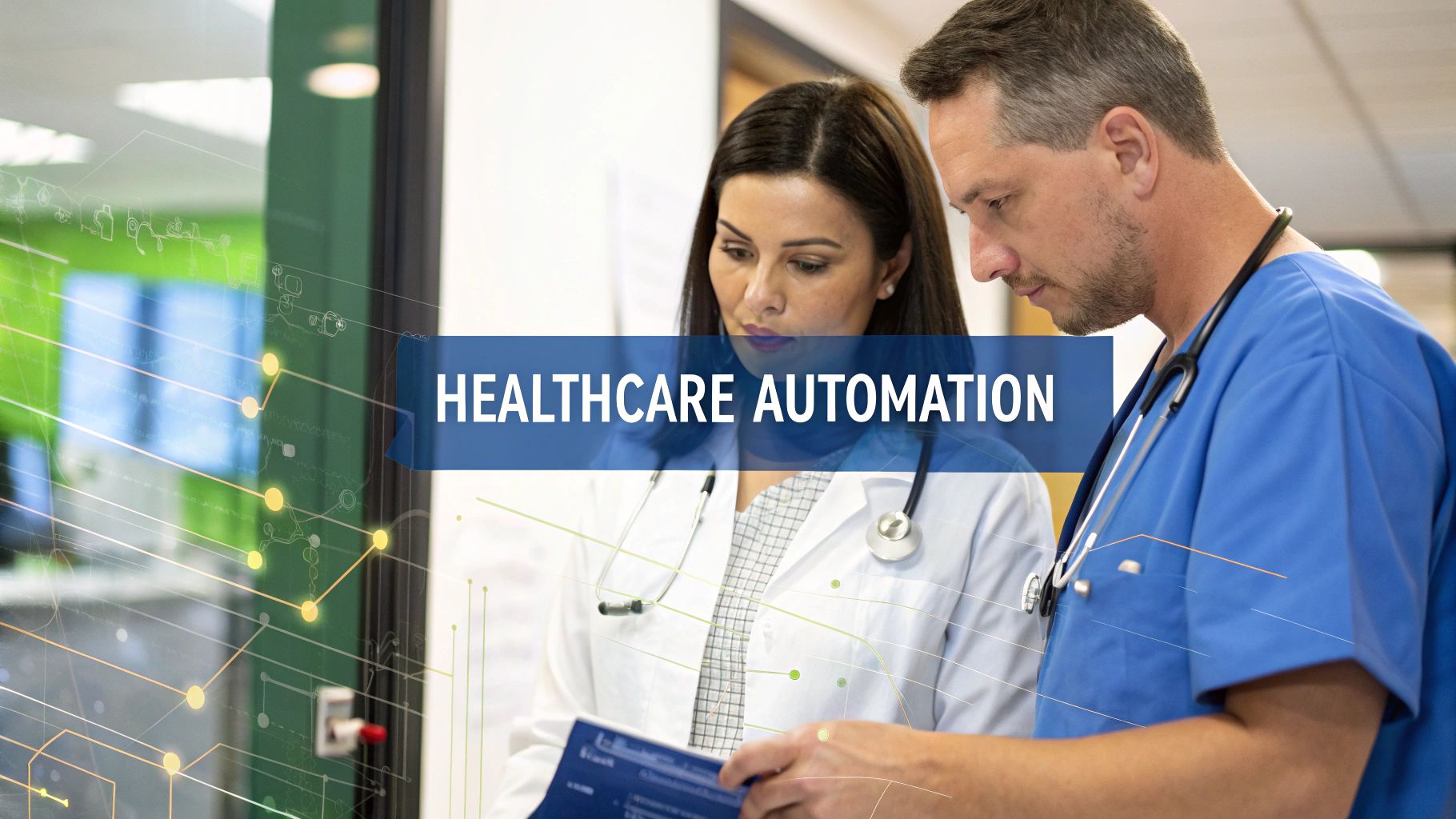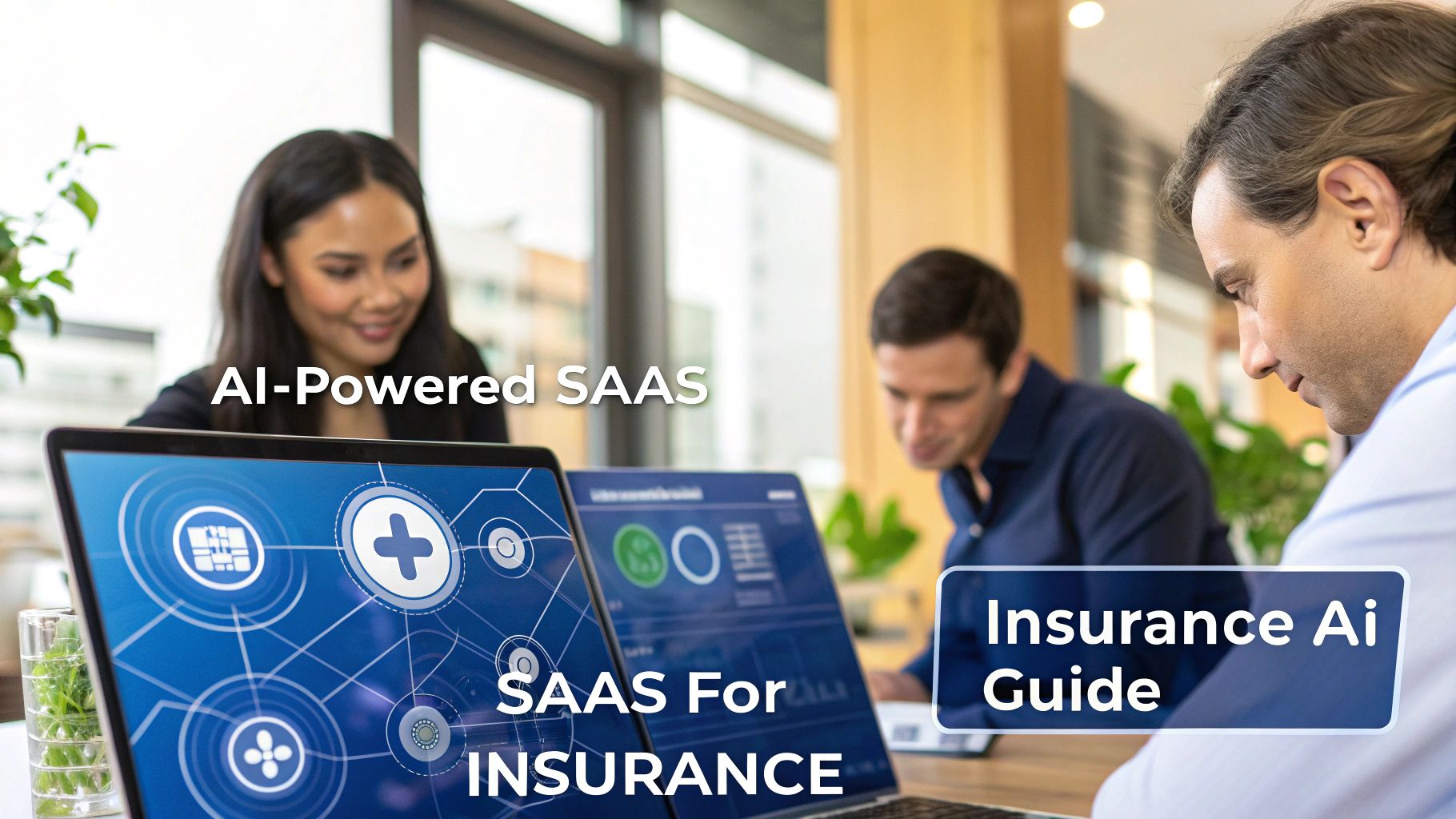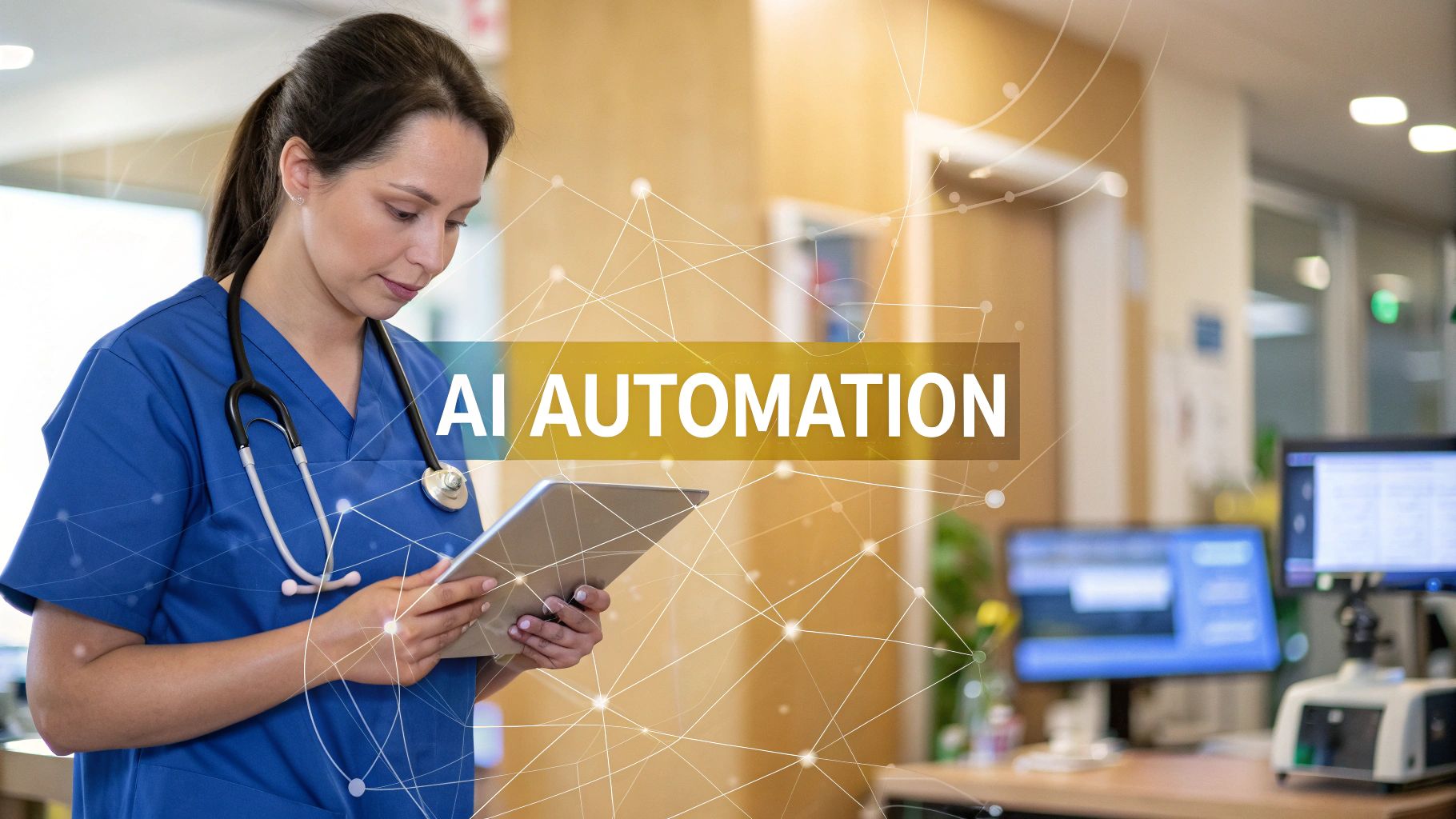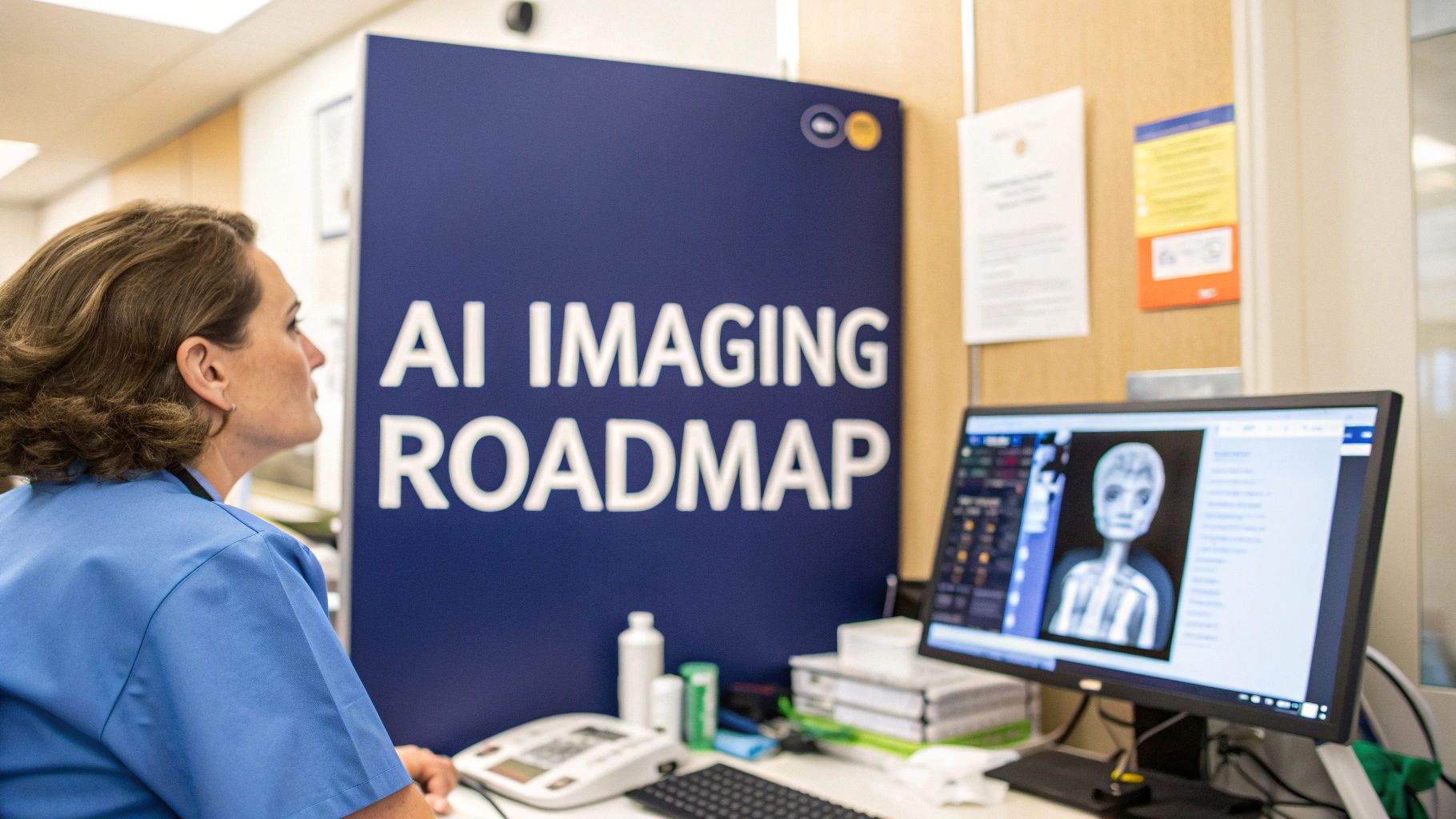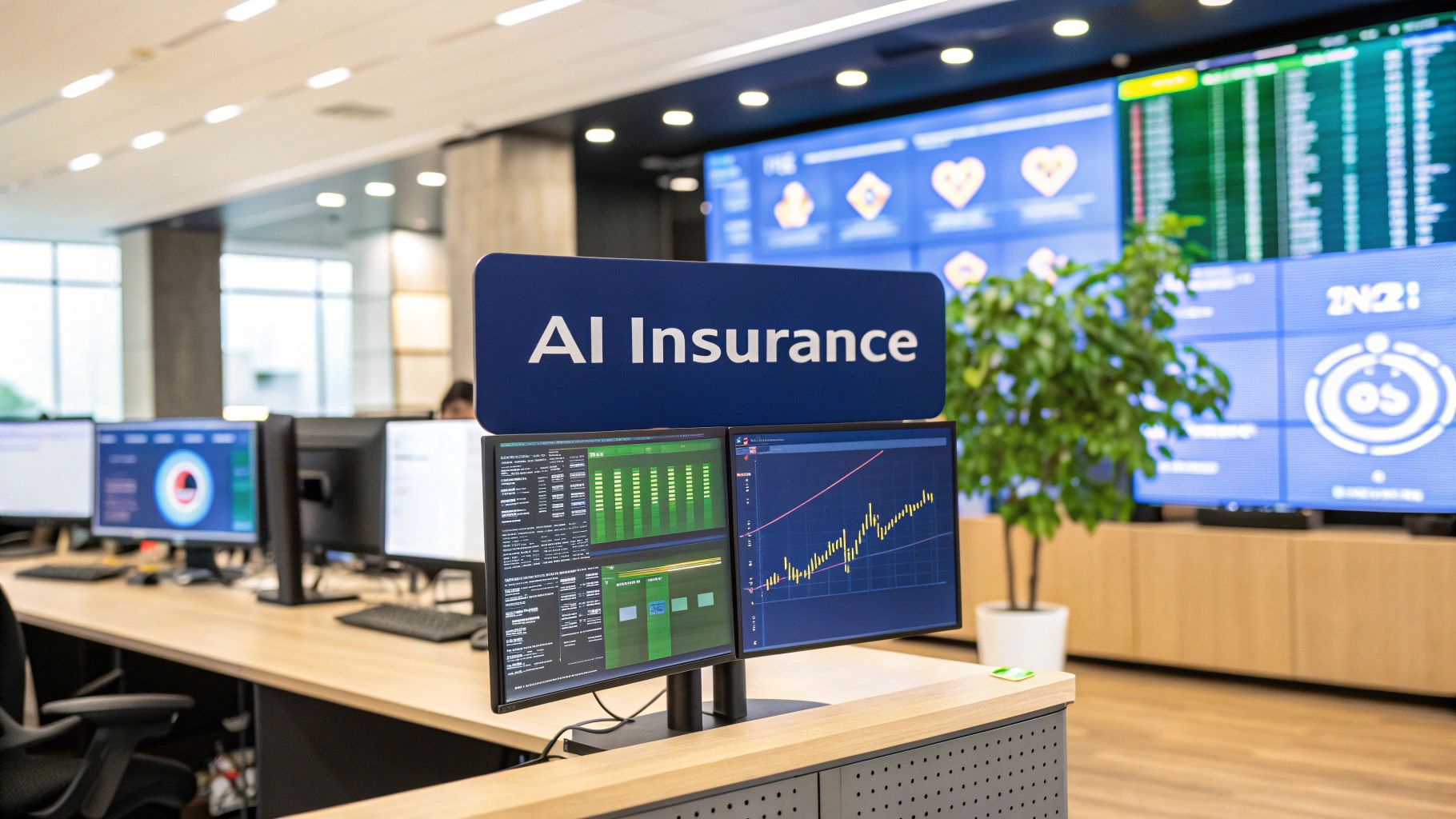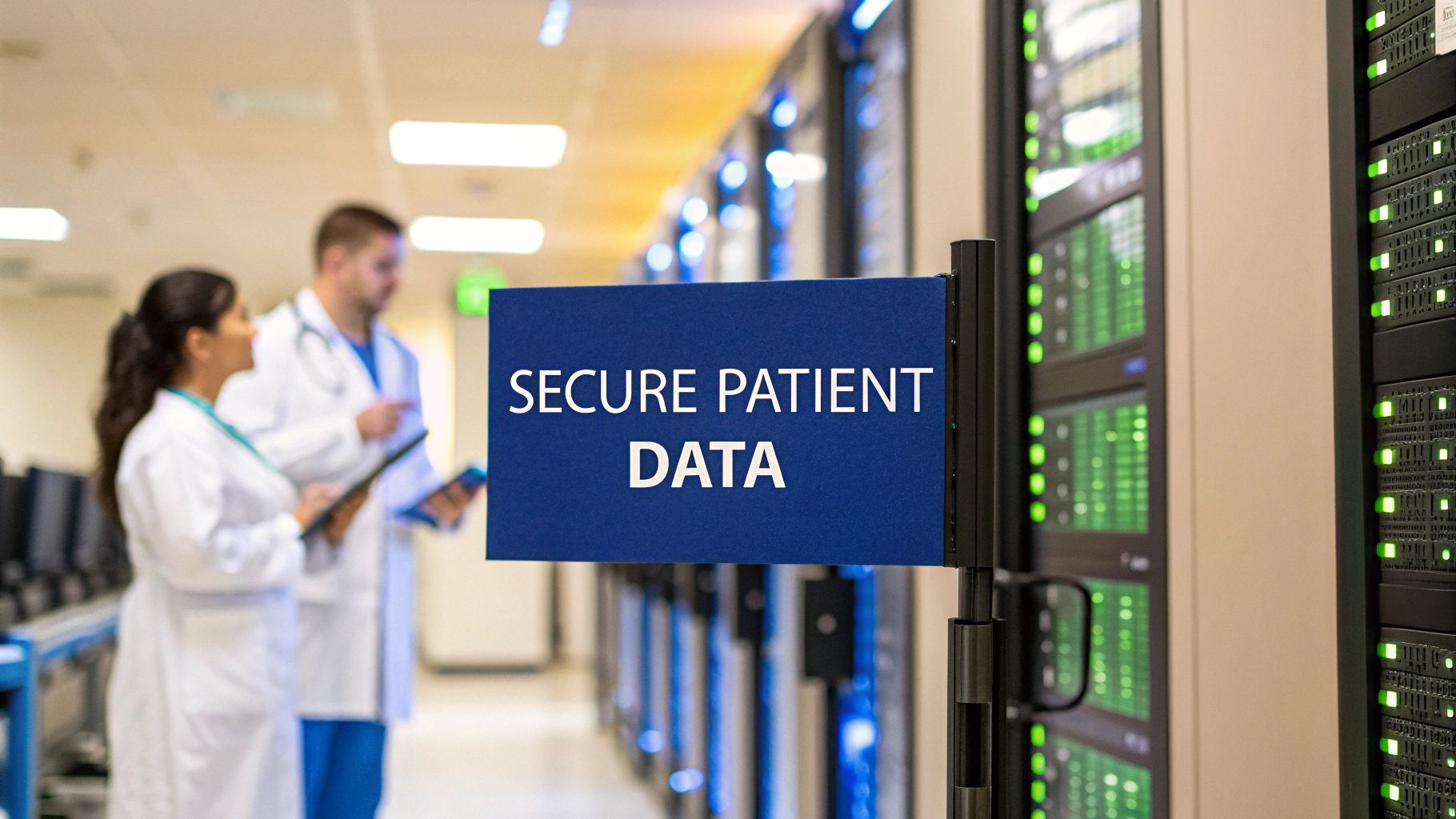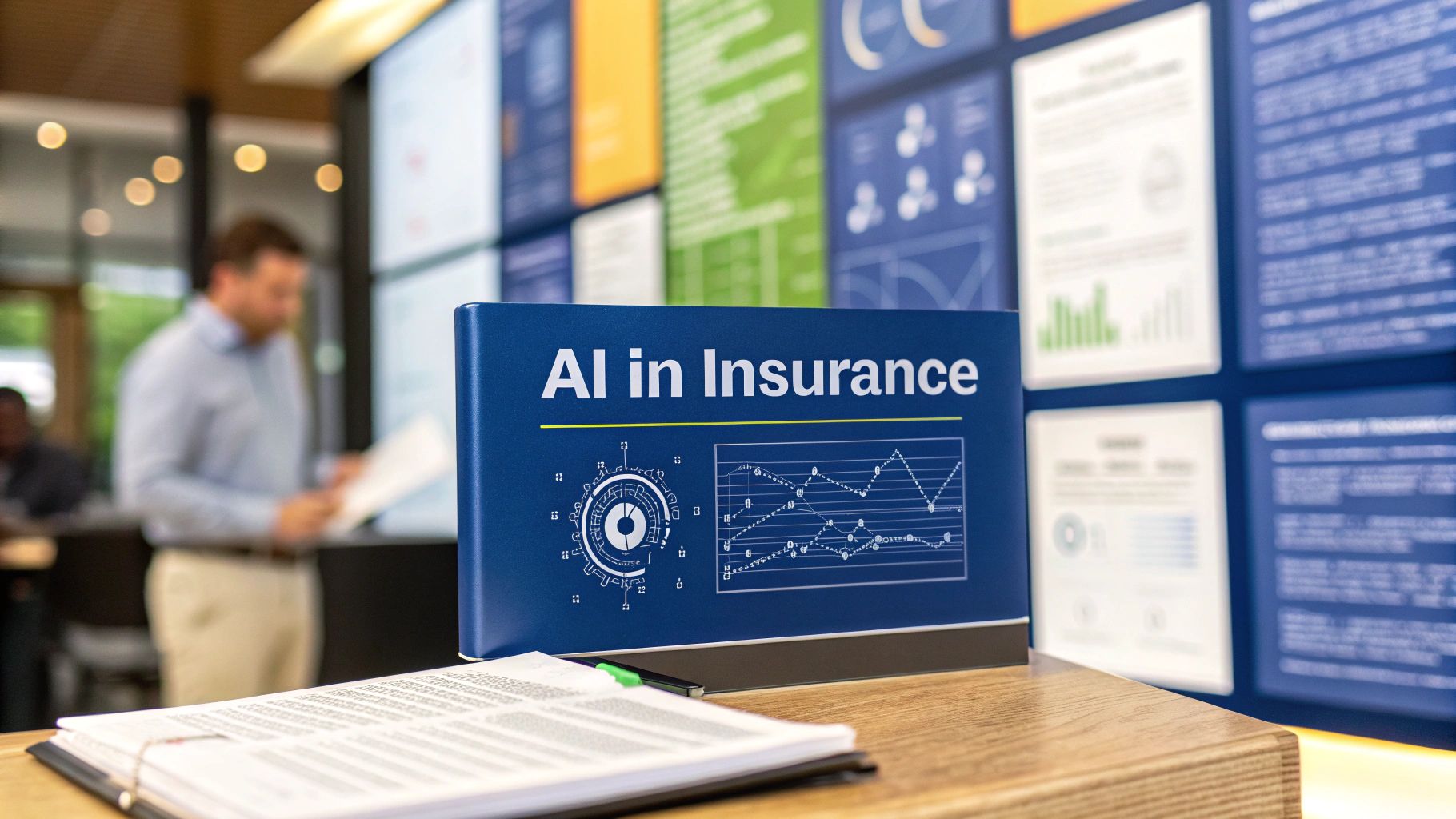Picture a hospital where nurses can focus entirely on their patients, not on piles of paperwork. That’s the real-world promise of healthcare automation, using technology to manage the repetitive administrative and clinical chores that bog down the system. The goal isn't to replace skilled professionals but to give them intelligent tools that boost efficiency and, most importantly, improve patient care.
What is Healthcare Automation Really?
At its core, healthcare automation is all about strategically using technology to simplify workflows, cut down on manual tasks, and get information moving smoothly throughout a healthcare organisation. It's like building a digital workforce that works right alongside your human teams. This digital crew takes on the predictable, rule-based jobs that often cause staff burnout and create operational gridlock.
This frees up doctors, nurses, and administrators to apply their valuable skills where they truly count: delivering better patient outcomes.

The applications here are incredibly broad. We're talking about everything from simple Robotic Process Automation (RPA) for handling billing to sophisticated Artificial Intelligence (AI) that can help with medical diagnoses. While the conversation often gets technical, the impact is deeply human.
The Before-and-After Picture
To really get it, let's look at a typical "before" scenario. In a busy clinic, a patient arrives and fills out paper forms. A staff member then has to key all that information into the Electronic Health Record (EHR) system. A nurse might later enter similar data again. Once the appointment is over, a medical coder manually sifts through the doctor's notes to assign billing codes, which then get handed off to another team to process the insurance claim. Every single step is a potential opportunity for human error, delays, and frustration.
Now, let's repaint that picture with automation:
-
Patient Intake: The patient pre-registers from their phone or computer at home, and their information populates the EHR automatically. No more clipboards.
-
Clinical Documentation: An AI-powered tool listens to the conversation between the doctor and patient, generating accurate clinical notes in real time.
-
Revenue Cycle: An automated system scans the patient record, applies the correct billing codes, and electronically submits the claim moments after the visit ends.
-
Appointment Scheduling: Smart chatbots manage appointment bookings, confirmations, and reminders 24/7, which helps slash no-show rates.
This isn’t just faster; it also creates a much more accurate and reliable data trail from start to finish.
More Than Just Efficiency
While making things run faster is a huge benefit, the true purpose of healthcare automation goes much deeper. It’s about creating a system that is more resilient, responsive, and puts the patient first. By taking the administrative weight off staff, these technologies are a direct answer to the high rates of burnout plaguing the medical field. Leading AI development Services are now developing incredibly sophisticated tools to help organisations achieve these exact goals.
By automating up to 80% of manual claims processing tasks, healthcare providers can significantly cut their administrative overhead. This allows them to shift resources back to where they belong: critical patient care initiatives.
This kind of progress is built on modern Healthcare Tech Solutions designed to fit neatly into existing operations. This gradual adoption is the key to unlocking bigger and better possibilities, like using data for advanced diagnostics, as we explored in our predictive healthcare with AI adoption guide. At Cleffex, our team is passionate about engineering these solutions, and you can learn more about our mission on our About Us page.
A Look Under the Hood: The Core Technologies of Automation
To really understand what makes healthcare automation work, we need to peek at the engines driving it. It’s not just one technology, but a team of powerful digital tools working together, each with a very specific role. Think of it as a highly skilled digital crew for your clinic or hospital.
This diagram shows how different types of automation fit into a modern healthcare environment, covering everything from simple administrative work to complex clinical support.

As you can see, there’s a clear structure here. Foundational automation takes care of the routine stuff, which frees up the more advanced systems to help with high-level decisions.
Robotic Process Automation (RPA): The Digital Administrator
Imagine you had an administrative assistant who never got tired, never made a typo, and could work 24/7. That's pretty much Robotic Process Automation (RPA) in a nutshell.
RPA uses software "bots" that are programmed to mimic repetitive human actions on a computer. These bots interact with digital systems just like a person would, like clicking, copying, pasting, and filling out forms. It’s not about intelligence; it's about following a script perfectly, every single time. In healthcare, RPA is the workhorse that takes on the high-volume, predictable tasks that often bog down staff.
What can RPA do?
-
Claims Processing: Shuttling data from an electronic health record (EHR) straight into the billing system without any manual entry.
-
Appointment Scheduling: Managing clinic calendars and automatically sending out reminders to patients.
-
Data Entry: Pulling patient details from new intake forms and accurately entering them into the hospital’s main database.
For most organizations, RPA is the first logical step into automation. Why? Because it tackles the most tedious administrative jobs and delivers a clear, fast return on investment.
Artificial Intelligence (AI): The Digital Brain
If RPA represents the hands doing the work, then Artificial Intelligence (AI) is the brain thinking. AI goes way beyond just following rules. It’s about building systems that can perform tasks that would normally require human intelligence, things like learning, reasoning, and solving problems.
AI can sift through enormous, complicated data sets to spot patterns, make predictions, and give clinicians a major leg up in their decision-making. For example, an AI algorithm can be trained on thousands of medical scans to learn how to identify the faint, early signs of a disease that a person might overlook. The AI doesn't make the final call; that's always the doctor's job, but it provides a powerful second set of eyes. This partnership between human expertise and machine analysis is where the magic really happens.
Machine Learning (ML): The Engine of Improvement
Machine Learning (ML) is a key part of AI. It’s the technology that allows a system to learn and get better from experience without needing a human to reprogram it. Think of it as the AI’s built-in personal trainer.
The more data an ML model is exposed to, the smarter and more accurate it becomes. This is a game-changer for healthcare. An ML model designed to predict patient readmission risks will constantly refine its own algorithm by analyzing the outcomes of past cases. This continuous learning cycle is what makes automation truly intelligent. The synergy between AI, ML, and connected devices is the backbone of today's digital health operations, a topic we explore further in our guide on smarter automation with AI and IoT.
To help clarify how these technologies fit together, here's a quick breakdown of their roles.
Key Automation Technologies and Their Healthcare Roles
|
Technology |
Core Function |
Example Application |
|---|---|---|
|
Robotic Process Automation (RPA) |
Mimics repetitive, rule-based human tasks. |
Automatically processing insurance claims by moving data between systems. |
|
Artificial Intelligence (AI) |
Analyzes complex data to make predictions and support decisions. |
Reviewing medical images (X-rays, MRIs) to flag potential abnormalities for a radiologist. |
|
Machine Learning (ML) |
Learns from data to improve performance over time. |
A system that predicts patient no-show rates and gets more accurate with each new dataset. |
This table shows a clear division of labour. RPA handles the manual grunt work, while AI and ML provide the intelligence and learning capabilities needed for more complex challenges.
In short, RPA takes care of the "doing," while AI and ML handle the "thinking" and "learning." This layered approach is what allows healthcare organizations to build a complete automation strategy that works for everyone, from the front desk to the operating room.
This integration is pushing the entire field forward. As technology evolves, processing information in real-time is becoming the new standard, with techniques like unlocking low-latency analytics and GenAI with real-time data streaming setting the stage for the next wave of healthcare innovation.
Real-World Applications in Patient Care
You can talk about technology all day, but what really matters is how it helps people. In healthcare, automation is actively changing how patients experience care, from the moment they first reach out for help to their ongoing health management.
These aren't just concepts on a whiteboard; they are practical tools making a difference right now.

From diagnostics to the daily grind of paperwork, here’s a look at how automation is making healthcare more precise, efficient, and, surprisingly, more human. By taking over the repetitive, time-consuming tasks, this technology lets clinicians get back to what they do best: caring for their patients.
Enhancing Diagnostic Accuracy and Speed
Medical imaging is one of the most compelling areas where automation shines. Think of AI algorithms as a highly trained assistant for radiologists. After being trained on millions of X-rays, CT scans, and MRIs, these systems can spot subtle patterns that the human eye might miss.
They can flag potential trouble spots that could indicate the early stages of a disease, helping radiologists prioritise the most urgent cases. This isn't about replacing an expert's judgment. It's about augmenting it, sharpening their focus, and ultimately leading to earlier diagnoses and quicker treatment for patients.
Streamlining Patient Communication and Scheduling
So much of healthcare involves administrative hurdles. Just think of the back-and-forth phone calls for booking appointments, sending reminders, and handling follow-ups. This is exactly the kind of work automation was built for.
-
Intelligent Appointment Booking: AI-powered chatbots on a clinic's website or app can schedule appointments 24/7. This frees up the front desk staff and makes it far easier for patients to get on the calendar.
-
Automated Reminders: A simple, automated text or email reminder has been proven to significantly cut down on no-shows, a major source of lost time and revenue for any practice.
-
Post-Visit Follow-Up: After a procedure, automated systems can check in on patients, send over recovery instructions, and even flag concerning responses for a nurse to review personally.
This kind of organised, consistent communication helps patients feel cared for every step of the way. As we've explored before, this has a massive impact on AI-powered patient care.
Reducing the Burden of Clinical Documentation
Burnout among doctors and nurses is a massive problem in healthcare, and a huge part of that comes from the sheer volume of paperwork. This is where "ambient listening" technology is making a real impact.
These sophisticated AI tools can securely listen to the natural conversation between a doctor and patient and automatically create structured, accurate clinical notes. It’s a simple but profound shift. It means doctors can look their patients in the eye and have a real conversation, rather than staring at a screen and typing.
By automating clinical note-taking, we can literally give clinicians hours back in their day. This time can then be reinvested into what really matters: complex decision-making and genuine patient connection.
The benefits are already clear. For example, some programs using this and other AI tools have seen a 15% reduction in emergency room visits and a 9% decrease in hospital admissions. It’s powerful proof that automation can improve both patient outcomes and how resources are used.
Of course, with all this automation comes the critical need for tight security and oversight. That's why tools like healthcare compliance management software are non-negotiable. They ensure every automated process follows strict privacy regulations, protecting sensitive patient information at all times.
At the end of the day, these real-world examples show that automation is an incredible ally in the mission to deliver better care. It's about creating smarter workflows and better tools so clinicians can focus on the human side of medicine.
The Measurable Benefits of Automation
Bringing automation into healthcare isn't just about getting with the times; it’s about seeing real, measurable returns that make the entire organisation stronger. When you start to smooth out those clunky administrative and clinical workflows, the positive effects are felt everywhere, in your operations, your finances, and most importantly, in the quality of patient care.
The case for automation gets pretty clear when you look at it from four different angles. Each one tackles a major headache in modern healthcare, from runaway costs to an exhausted workforce.
Driving Superior Operational Efficiency
In healthcare, efficiency is more than just speed. It's about getting things right, every single time, and letting your talented staff focus on what they do best. Automation is perfect for handling those high-volume, repetitive tasks that eat up so much time and are ripe for human error.
Take the revenue cycle, for instance. Processing claims by hand is slow and full of pitfalls that lead to denials and payment delays. By automating this process, providers see immediate wins:
-
Faster Reimbursement Cycles: Claims get submitted correctly the first time around, shortening the whole accounts receivable timeline.
-
Reduced Administrative Errors: Automation gets rid of the typos and data entry mistakes that cause expensive claim rejections.
-
Increased Staff Productivity: Your team can step away from mind-numbing data entry and focus on handling complex cases or helping patients.
Achieving Significant Cost Reduction
Administrative waste puts a massive financial strain on the healthcare system. For hospitals and clinics dealing with staff shortages and high overhead, automation has become an essential tool. With administrative costs making up an estimated 15% to 30% of all healthcare spending in the U.S., automation provides a direct way to trim that fat.
By automating tasks like billing, coding, and scheduling, healthcare providers can slash per-claim processing costs by up to 80%. That can easily add up to millions in annual savings, money that can be put back into patient care and new innovations.
This kind of financial impact is one of the most compelling reasons to explore automation.
Enhancing Patient Outcomes and Safety
At the end of the day, everything in healthcare comes back to improving patient health. Automation plays a direct role here by creating a more reliable and responsive care environment. For example, automated systems can ensure a patient's complete and up-to-date data is right at a clinician's fingertips, which helps cut down on the risk of medical errors.
Automation also opens the door to more personalized treatment. AI algorithms can analyze patient histories to flag individuals at high risk for certain conditions, which allows for much earlier intervention. This proactive mindset shifts the focus from just treating sickness to actively preventing it, leading to much better long-term health. You can learn more about the broader benefits of AI in the healthcare industry in our detailed article.
Improving Staff Morale and Retention
Clinician burnout is a genuine crisis, and a huge part of it is the mountain of administrative work. By taking tedious tasks off their plates, automation directly tackles a major source of their frustration.
When doctors and nurses can spend less time filling out forms and more time actually talking to their patients, their job satisfaction shoots up. This doesn't just improve the quality of care; it helps keep good people on your team, which is a massive challenge for nearly every healthcare organisation today. Investing in technology that supports your staff sends a powerful message: their time and well-being matter.
Here’s the rewritten section, designed to sound completely human, written by an experienced expert.
Getting Past the Hurdles: Common Implementation Challenges
Moving to an automated setup in healthcare isn't like flipping a switch. It’s more like building a bridge from the way things have always been done to a much more efficient future. While the payoff is huge, the journey has its share of bumps. Knowing what to expect and planning for these obstacles is the key to a smooth transition.
Let's be honest: integrating new tools with old systems, keeping patient data locked down, and managing the initial cost can feel overwhelming. But tackling these challenges with a clear strategy from the get-go makes all the difference.
The Legacy System Puzzle
One of the biggest headaches is getting shiny new automation tools to talk to older Electronic Health Record (EHR) systems. Many of these legacy platforms were built like fortresses, solid and reliable, but not designed to play nicely with others. This can create frustrating data silos, which is the exact opposite of the connected workflow you're trying to build.
So, what’s the answer? Don't try to boil the ocean. A phased rollout almost always works best. Start with a small pilot project focused on a single, high-impact area, like appointment scheduling or patient intake. This lets you prove the value quickly, work out the technical kinks on a manageable scale, and build momentum before going all-in.
Keeping Data Safe and Staying Compliant
In healthcare, protecting patient information is everything. Every piece of your automation puzzle must comply with strict privacy laws like HIPAA. That means rock-solid encryption, tight access controls, and a crystal-clear audit trail for every automated task. It's simply non-negotiable.
The regulatory landscape is also getting more complex. California, for instance, is rolling out new laws specifically for AI in healthcare. Starting in 2025, Assembly Bill 3030 and Senate Bill 1120 will bring in new rules about disclosing AI-driven patient communication and ensuring doctors remain in control of clinical decisions. This shows just how important it is to build your compliance framework to meet both federal and evolving state-level standards.
The bottom line is this: compliance can't be a box you tick at the end. It has to be baked into your Healthcare Automation strategy from the very beginning.
Juggling Costs and Getting Your Team On Board
The upfront cost of automation can cause some sticker shock. The trick is to frame it as an investment, not an expense. When you build a business case that clearly shows the long-term savings from fewer manual errors, faster billing, and a more productive team, it's much easier to get leadership to see the value.
Just as important is the people side of the equation. Your staff might worry that automation is coming for their jobs. That's why great training is so critical. It’s not just about teaching them which buttons to press. It’s about showing them how these new tools will free them up from tedious tasks and let them focus on what matters most: patient care. When your team sees automation as a partner that makes their work more meaningful, they'll be your biggest champions. Working with seasoned AI Development Services can help you navigate both the technical and human elements, creating custom Healthcare Tech Solutions that set everyone up for a win.
How to Get Started with Healthcare Automation
So, where do you begin? Diving into automation doesn't mean you have to rip out your existing systems and start from scratch. The best approach is a practical one, start small, prove the concept, and build momentum from there. It's all about delivering value at every step.
The journey starts with a simple question: Where does it hurt the most? Look for the biggest bottlenecks in your daily operations. Maybe it's the long queues at patient intake that are frustrating everyone. Or perhaps your revenue cycle is tangled up in manual claims processing, leading to costly errors. Finding these high-friction points gives you a perfect target for your first automation project.
Figure Out What You Really Need
Once you’ve pinpointed a problem area, it's time to dig a little deeper with a needs assessment. This is where you define what a "win" actually looks like. Get specific. Your goals should be measurable, something like cutting claim denial rates by 20% or slicing patient check-in times in half.
This is also the ideal moment to find a technology partner who can help guide you. An experienced firm can take a look at your current setup, map out your workflows, and help you pick the right tools for the job.
The smartest way to start is with a contained pilot project. A pilot lets you show real, tangible value to stakeholders quickly. You can iron out any kinks on a small scale and build a solid business case for expanding your efforts.
Building Your Solution and Scaling Up
A good partner can help you build and implement the right Healthcare Tech Solutions for your specific challenges. Think of the pilot as creating your blueprint for success. After you've hit your initial targets, you can use those results to roll out the solution to other departments or processes. This step-by-step method keeps risk low and ensures every new automation phase is built on a proven foundation.
Ultimately, automation isn't some far-off concept; it’s an essential and accessible step for any modern healthcare provider. It’s about making practical changes today that boost efficiency and, most importantly, improve patient care. As we've covered in our predictive healthcare with AI adoption guide, the right strategy turns this technology into a powerful ally.
To see how we put this into practice and meet the team behind our work, check out our about us page.
Your Questions About Healthcare Automation, Answered
Even with all the benefits on the table, it's natural to have questions before diving into automation. Let's tackle some of the most common ones we hear from healthcare professionals, so you can move forward with a clear picture.
Will Automation Replace Doctors and Nurses?
Not a chance. The purpose of Healthcare Automation isn't to replace your skilled medical team; it's to support them. The goal is to take over the repetitive, administrative work that so often leads to burnout.
Think of it this way: automation frees up your clinicians to focus on what truly matters, like complex diagnoses, hands-on patient care, and the human connection that technology can never replicate. It helps your team operate at its best.
Is Automation Only for Large Hospitals?
That's a common myth, but it's definitely not the case anymore. While big hospitals were the first to jump on board, today's cloud-based tools have made automation practical and affordable for smaller clinics and private practices, too.
Even small-scale automation can make a massive difference. For smaller practices, the biggest wins often come from:
-
Automating appointment scheduling and patient reminders.
-
Simplifying the billing and insurance claims process.
-
Using digital forms for patient intake to eliminate manual data entry.
How is Patient Data Kept Secure with Automation?
Security is non-negotiable in healthcare, and any worthwhile automation platform is built with this in mind. These systems are designed to be HIPAA-compliant right from the start, using powerful data encryption, strict access controls, and detailed audit logs to protect sensitive patient information.
Choosing the right technology partner is key. You need a team with a proven track record in the healthcare industry. Their expertise ensures that all Healthcare Tech Solutions are built around a solid security foundation, protecting your patients and your practice.
What is the Biggest Barrier to Adoption?
If there’s one major hurdle we see time and again, it’s getting new automation tools to play nicely with existing legacy systems, especially Electronic Health Records (EHRs). These older platforms can be incredibly complex, which can make sharing data smoothly a real challenge.
Successfully navigating this requires careful planning. A phased, step-by-step rollout and a partner who specializes in healthcare system integration are your best bets. As we've covered in our guides on predictive healthcare with AI, the right strategy is everything. Top-tier AI Development Services know how to handle these technical puzzles. You can learn more about how we build that trust and expertise on our about us page.
Ready to see how automation can help your healthcare organisation thrive? The team at Cleffex Digital Ltd has the expertise to build secure, efficient, and scalable solutions that fit your unique needs. Get in touch with us today to start your automation journey.
